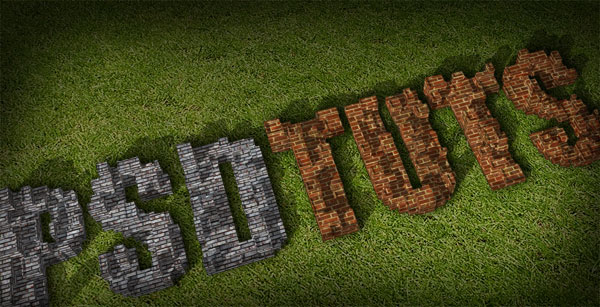
Photoshop is a powerful application on its own merits. Its power, however, can be significantly increased by using it in tandem with another application like Illustrator, Cinema 4D, or in this case, Google Sketchup. Today, we will create some cool 3D text using this free architectural application.
Step 1
Begin by downloading the free version of Google Sketchup here. When you first open Sketchup, you’ll be prompted with a dialog box asking what style to begin with. I have chosen the simple style, with blue sky and green ‘grass’ (this is completely your preference, it will have no effect on your final outcome). Open the main tool box by clicking View > Tool Palettes > Large Tool Set. There are a few tools we’ll make a lot of use of, so it’s helpful to familiarize yourself with their shortcuts. These are the same on Windows and Mac: select: (spacebar), push/pull: (p), offset: (f), orbit: (o), pan: (h), zoom: scroll up or down, or (z)
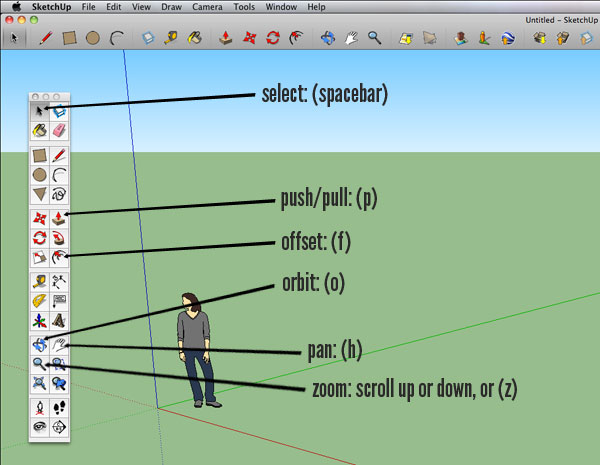

Step 2
We need to create a template for where we’re putting our buildings. We’ll do this by viewing everything from the top. To view from the top, go to Camera > Standard Views > Top. You should see the word "Top" in the upper left corner after you do this. You’ll want your red and green axes pretty close, so zoom in if necessary to get to a nice position (below). To grab the screen, use the pan tool (h) to help line everything up.
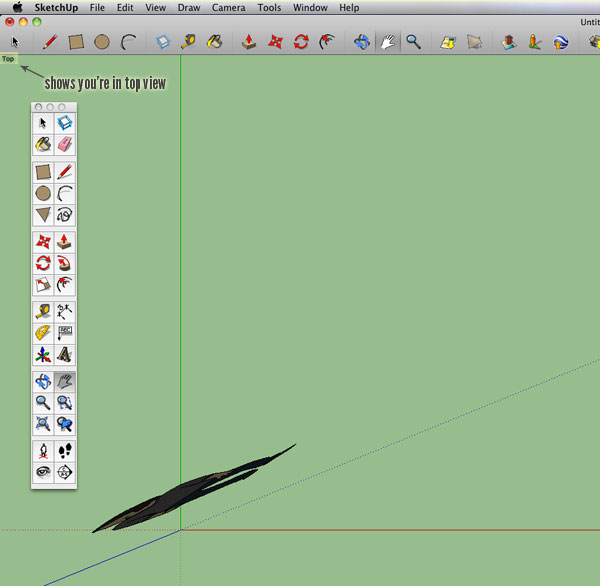

Step 3
Next, click on the 3D text tool and type in your text. Click on "Fonts" to change your font (thick stroked bolder fonts work best), and input a size of 10" or greater. Then click "Place"
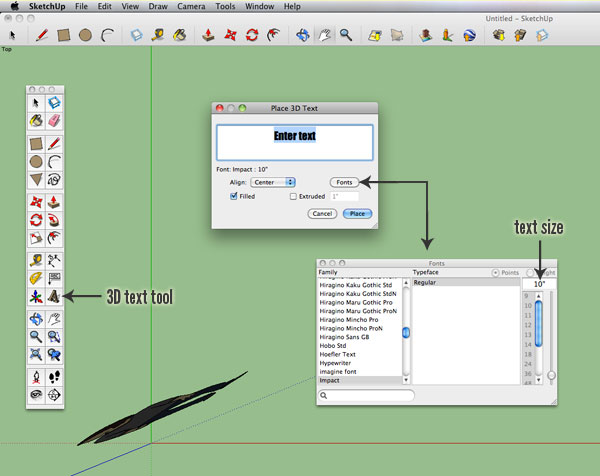

Step 4
Now, click where you’d like to put your text on your canvas. If you want to move it after you place it, make sure it’s selected (spacebar) + click, then click the move tool (m) and drag to the new location. If you’d like to make your text bigger, make sure it’s selected (spacebar) + click, then click the scale tool (s), grab a green node (a corner one to scale proportionally, they’ll turn red once selected), and drag until you’re happy.
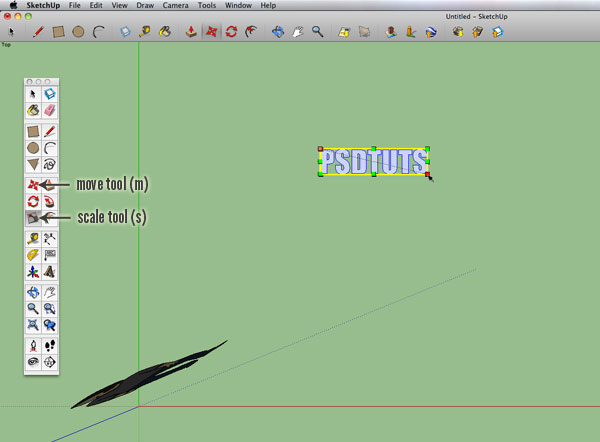

Step 5
Now we need to put this on a separate layer. Unfortunately, this is a multi-step task, but a very easy one. We need to start by opening our layers palette. Go to Window > Layers. Once the layers palette is open, click the little "+" sign in the top left corner and name the new layer.
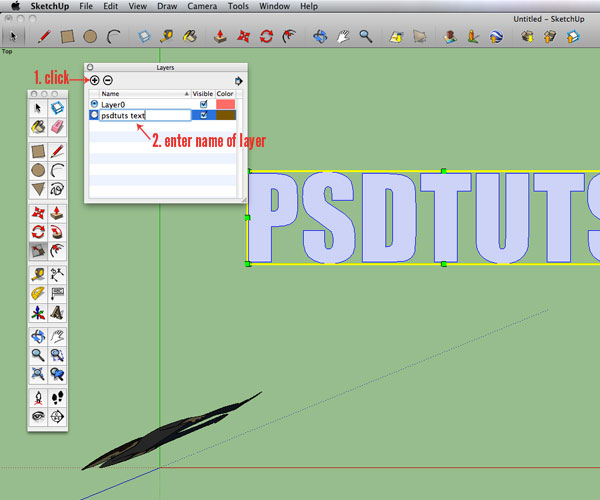

Step 6
Next, with your selection tool (spacebar), right click on your text and choose "Entity Info." A small dialog box will appear with a layer drop down menu. From this menu, choose the new layer you just named in Step 5.
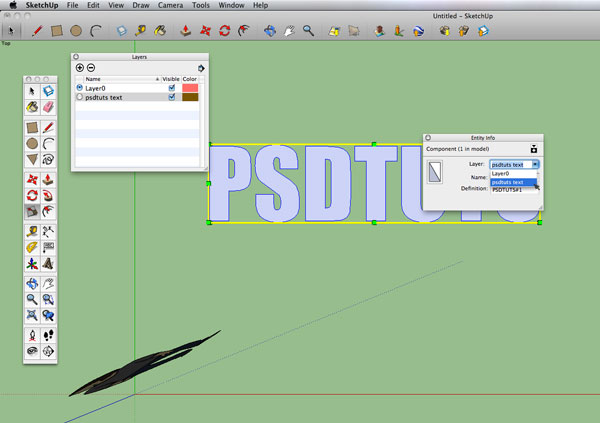

Step 7
Your text has been officially moved. Feel free to close your "Entity Info" box, and if you wish, you can check to make sure you put your text on the new layer by unclicking the little checkbox under "Visible" in your layers palette. To be sure we put everything else on a different layer, make sure the radial button in the layers palette near "Layer 0" is highlighted (the same as the image above). Now, time to get to business!
Step 8
Select your rectangle tool (r), and zoom in nice and close to your first letter. Begin drawing squares and rectangles to fill up your first letter. If you make a mistake, don’t worry. Cmd/Ctrl + Z will undo multiple steps in the history. You can also select any rectangle and just hit your backspace or delete key to get rid of it. Try your best each time you draw a new rectangle to share an edge with the previous one so there are no gaps between your rectangles. Don’t forget you can make your template text visible and invisible as you go to see your progress (in your layers palette, checkbox under "Visible"). Use the pan tool (h) to grab the screen and move to the next letter. Do this for all of your letters.
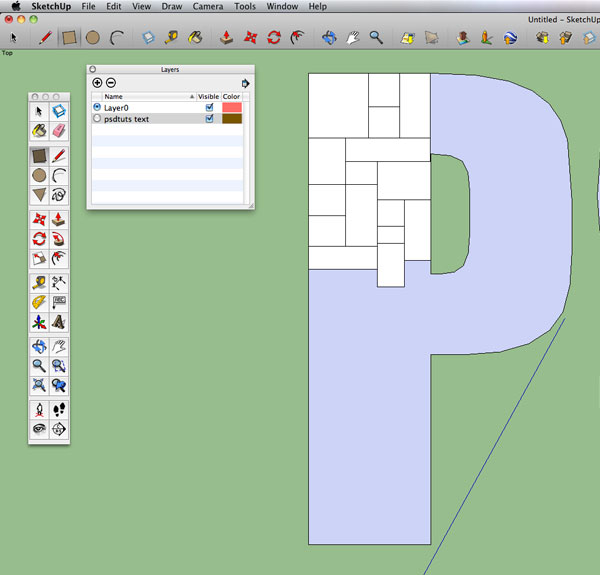
TIP: If you get a blue-ish/purple-ish square in there and it’s bugging you, just right click and select “Reverse Faces” to change it to white.

TIP: If you get a blue-ish/purple-ish square in there and it’s bugging you, just right click and select “Reverse Faces” to change it to white.
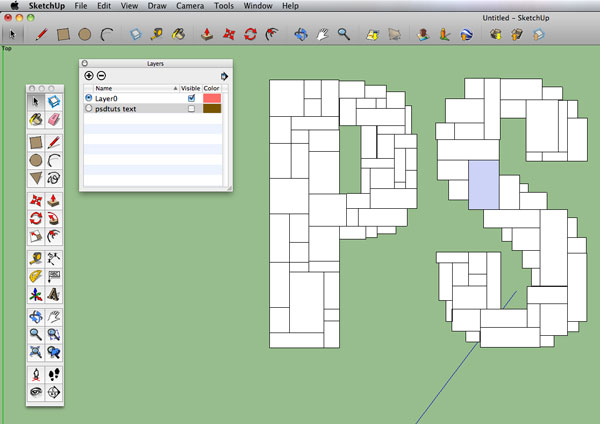
Step 9
Viola! All rectangled out! Go to your layers palette and make your template text invisible by unchecking the "Visible" box beside it. Fill in any gaps you might have missed or delete any excess. Now it’s time to texture. Go to Window > Materials to open the materials palette.


Step 10
In your materials palette, choose "Brick and Cladding" from the drop down menu, then click on the material you’d like to use for your buildings.


Step 11
With your selection tool (spacebar) rubber band to select the area you’d like to texture with your chosen material.
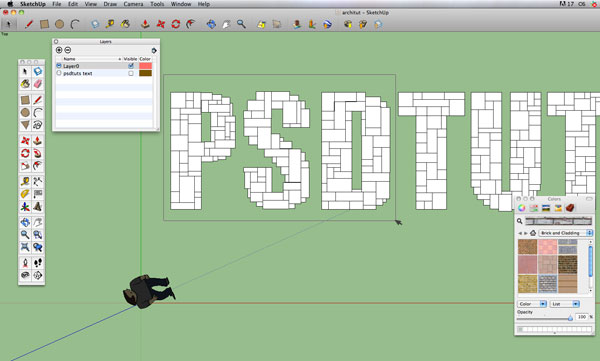

Step 12
Next, grab your paint bucket tool (b) and click on any of the squares that are selected. The entire selection will now be textured. If you are unhappy with the size of the texture, rubber band select all of your letters, then use the scale tool (s), grab a corner green node (to scale proportionally), and resize until you are happy with the size of the texture within your squares.
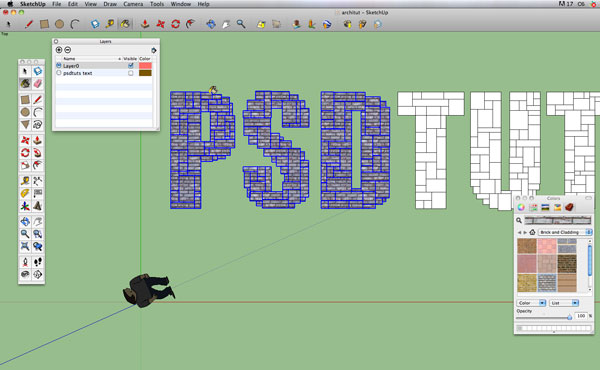

Step 13
Texture the rest of your squares. You can also texture each square individually, if you’d like to put a mixture of different textures together.


Step 14
Now for the fun part! Grab your orbit tool (o) and orbit to an angle similar to the one below.
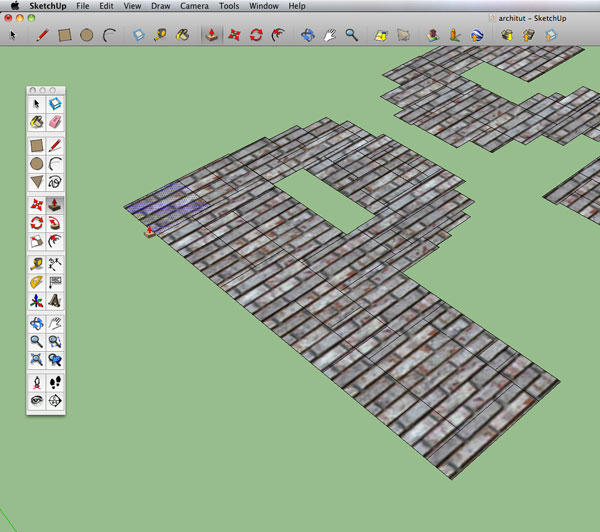

Step 15
Next, grab your push/pull tool (p) and place it over one of your squares until it highlights. Click, then drag upwards until you are happy with the height. Click to deselect. Move to the next square and repeat the process.
TIP: When you pull next to a previously pulled segment and you attempt to pull higher than it, you’ll receive an "Offset limitied to" red box (below). To continue pulling, click to end the segment, then click again to raise it higher.
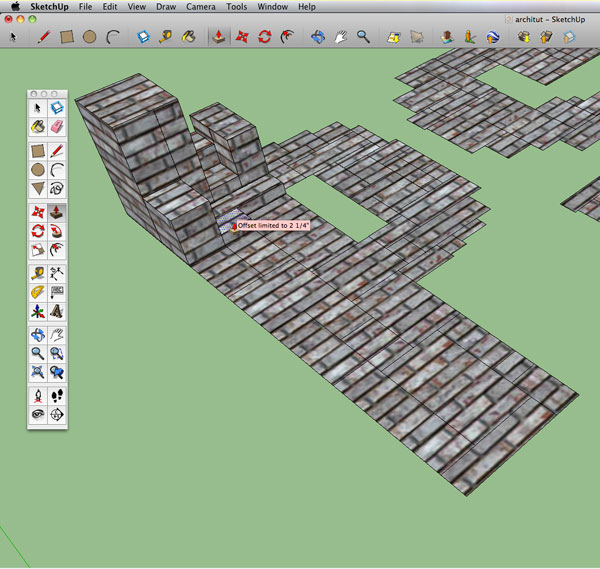

Step 16
Keep pulling until you’re happy with your mini city of letters. Use your orbit tool (o), pan tool (h), and zoom to scroll up and down, or (z), to navigate through and around all of your letters.


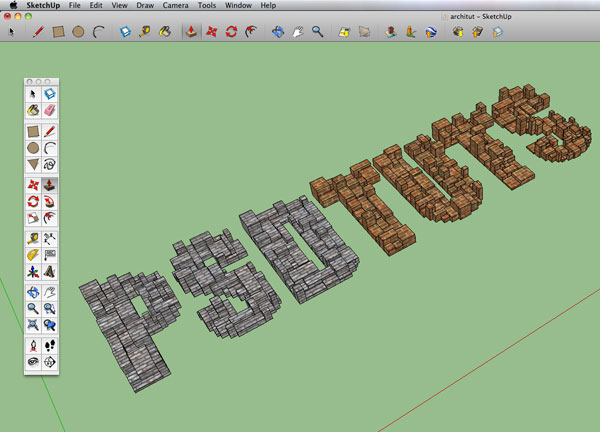
Step 17
Once you have all of your letters pulled, it’s time to change up a few roofs to add a little visual interest and detail. We’ll do this by using the offset tool (f). Zoom in closely to your first letter, grab your offset tool, and get close to the edge of the roof you would like to adjust. Once on the edge, click and move the offset tool inward, towards the center of the top of the building. You’ll notice new edges, forming what looks like a border. Release the tool by unclicking when you are satisfied by the width.
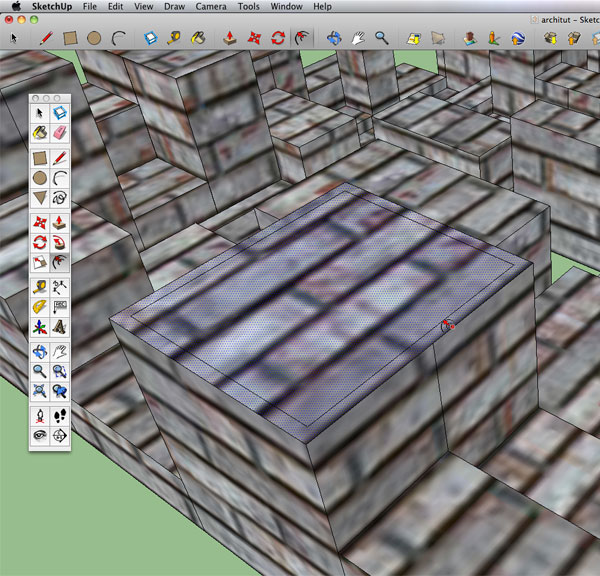
Step 18
Now, grab your push/pull tool (p) and once the center of the newly formed border is highlighted in blue, push downward to create a rooftop. Repeat these steps to random building tops on all of your letters.
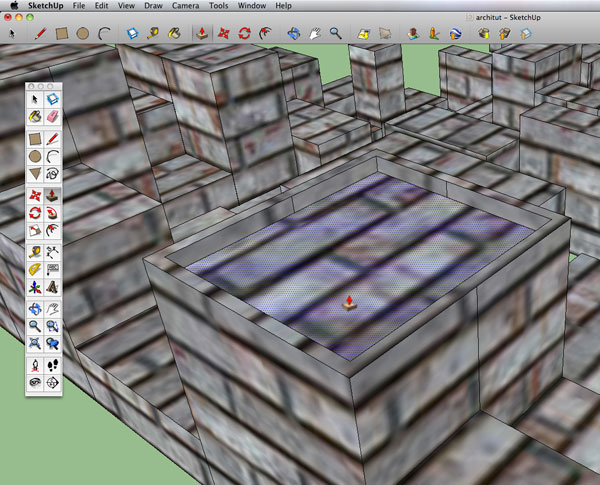

Step 19
Time to add some shadows! To add shadows, go to View > Shadows. Orbit around to get an idea of the angle you’ll want for your final composition. Not the look of the shadows for the time of year you want? No need to worry – that’s what the Shadows Palette is for. To open it, go to Window > Shadows. Once opened, input the precise date and time, or use the sliders to preview your shadows.

Step 20
Now we need to get this ready for export. To make things look a little more finalized, we’ll need to hide our axes and edges. To do this, go to View > Axes and uncheck it. To uncheck your edges go to View > Edge Style > Edges.
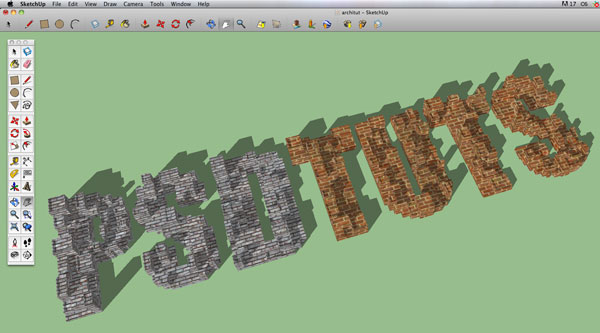
Step 21
That looks better. Get your text positioned exactly how you want it to look, making sure the entire piece fits on your screen. When you’re satisfied, go to File > Export > 2D Graphic. A dialog box shows up, and you have 3 options to choose from: jpeg, png, and tiff files. I’ve selected a tiff file. If you click "Options…" a second box shows up where you can specify exact dimensions and resolution, as well as rendering options. I’ve chosen the settings below for mine. The width and height are the default screen size, which is why making sure your entire piece fits on your screen is important. For whatever reason, even if you put in a resolution other than 72ppi, it will still open as 72ppi. Luckily, it’ll be large enough where you can adjust it in Photoshop when you scale it down. When you’re ready, Export away. Time to take it into Photoshop!
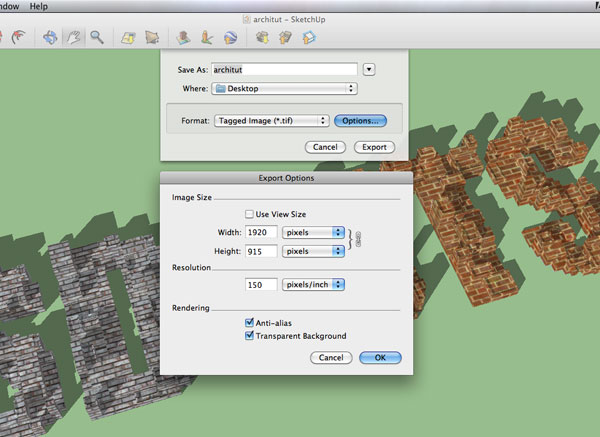
Step 22
Now that we’re in Photoshop, open your 2D graphic file from where you saved it. Next, let’s get our canvas a little easier to work with. To change the canvas size, go to Image > Canvas Size and add a bit more height, then crop (c) at the resolution you prefer (mine’s at 150ppi). Name your layer Original.


Step 23
Let’s take care of those horrible green shadows. Select them using your magic wand tool (w) and shift-click to add each additional piece. Now that they’re all selected, go to Select > Modify > Expand. Input 1px and hit Ok.
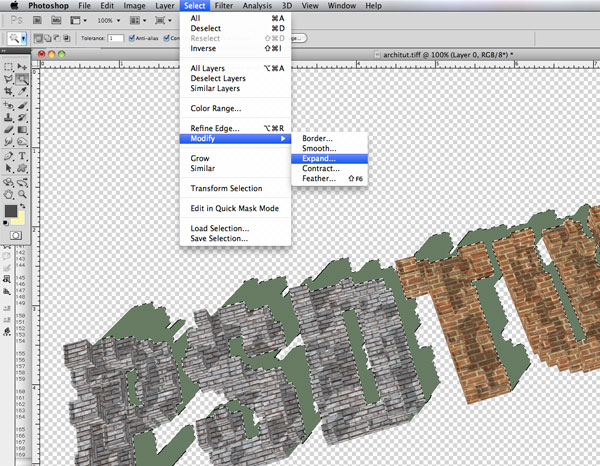
Step 24
Now hit Delete or Backspace to remove the green shadows from the original image. Keeping your selection, create a new layer and call it Main Shadows. Make your background color black, then hit Cmd/Ctrl + Backspace to fill the selection with black. Set this layer’s opacity to 40%.
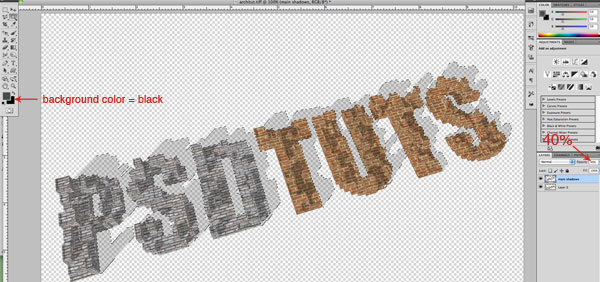
Step 25
Now we need to bring in a background. I’ve used a grass texture which you can get here. Place the image in a layer below Original and name it Grass.

Step 26
It’s pretty obvious our grass needs some darkening up here. Create another layer right on top of it, fill it with black, and name it Dark. Set this layer’s opacity to 35%.

Step 27
Following the direction of the shadows off of the text, and to make the focal point more concentrated on the text, create a new layer above Dark. Create additional shading to the grass just above the text using a large soft brush. Name this layer Extra Dark and set the opacity to 25%.
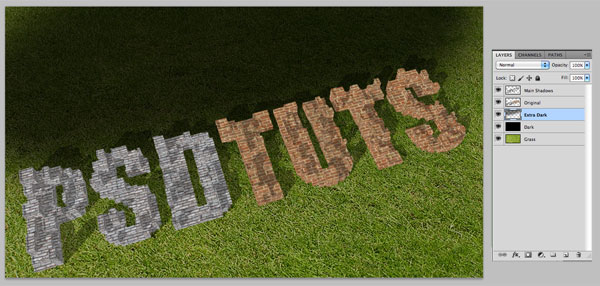
Step 28
To get the grass following the same perspective as our letters, we need to distort it. Cmd/Ctrl + T to free transform your grass, right click, and choose Distort. Grab the corner nodes to follow the angles of the first and last letters for each side.

Step 29
Now to juice up these letters! Cmd/Ctrl-click the Original’s layer thumbnail to select its content. Create a brightness and contrast adjustment layer, setting brightness to -31, and contrast to 100.
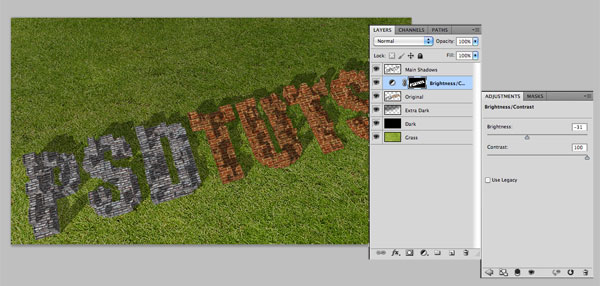
Step 30
Now we need to add a couple of layer styles to the Original layer. Double click the layer, and check Drop Shadow. Add the settings below. I’ve turned off global light and chosen an angle to make the drop shadow match the Original’s shadows, so choose an angle for your own that will best match up with yours.
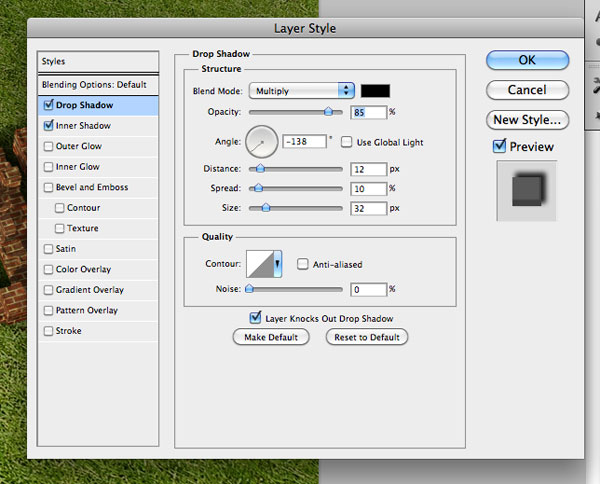
Step 31
Next, check Inner Shadow. We’re just going to add a very, very subtle shadow that will be apparent on the bottom edges of all the letters just to give it a little extra depth. Add the settings below, but adjust the angle for your own piece to match that bottom edge.

Step 32
Next, crop your image for your final composition or look.
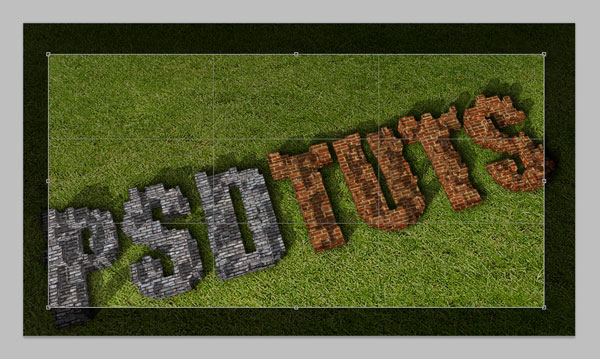
Conclusion
Create a new layer at the very top and with a soft brush, lightly shade the outer edges and corners for a final touch. Google Sketchup is a great alternative to the Repousse tool, especially if you don’t have CS5, and there are plenty of video tutorials on Youtube for learning new features. Thanks for reading!
